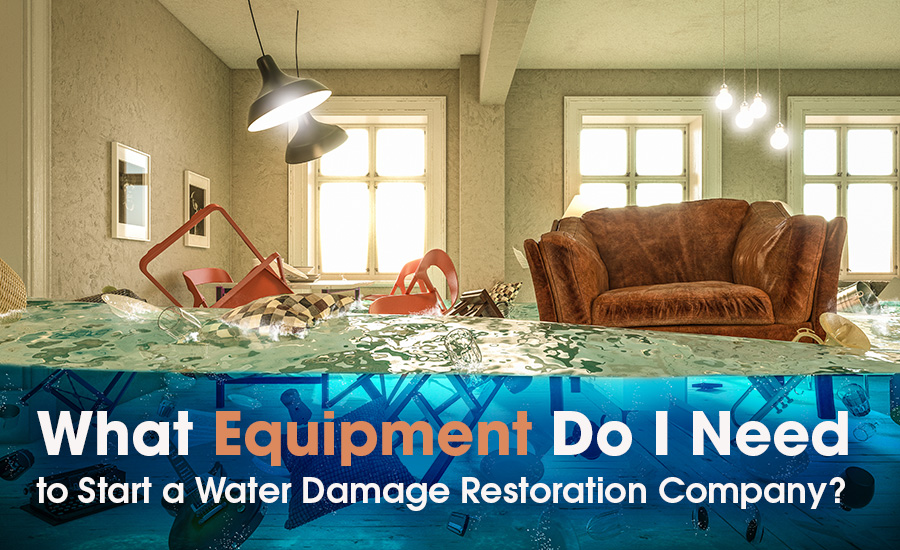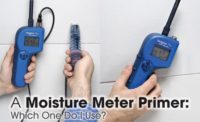What Equipment Do I Need to Start a Water Damage Restoration Company?

Starting your own business is never an easy task, no matter which field you want to work in. But it’s especially difficult to open a water damage restoration company — after all, there are so many things to take care of. You need certifications and licenses, insurance plans and coverages, water damage equipment, and vans for transportation. In short, it’s not a job for the faint of heart.
But that doesn’t mean it’s impossible. In fact, with the right kind of information, your company can grow from an idea to a real business. So let’s start with the basics — the type of equipment you’ll need to do your job well.
Moisture Meters
Every water damage restoration company needs moisture meters — these are basic diagnostic tools for contractors. Moisture meters allow you to measure and locate moisture damage and map out the drying strategy.
But they aren’t used only for water damage. They can also determine the amount of moisture in wood and tile and gauge how dry they should be. Typically, these devices are easy to use and can even reach into tight areas and openings.
Air Movers
When we’re talking about water damage drying equipment, nothing’s quite as important as air movers. These devices are similar to fans — they increase air circulation, speed up water evaporation, and reduce the time needed for drying. However, air movers are typically less bulky. Thus, they are easier to carry upstairs or downstairs and don’t need quite as much maintenance.
All air movers have the same purpose — to help the room dry. However, different types of water damage require different kinds of air movers. If you’re not sure which types there are, don’t worry — here are the three most common ones.
Axial Air Movers
Every contractor should have one axial air mover for drying large, wide surfaces. These devices move air horizontally, producing high airflow and ensuring the drying process is completed fast. Thanks to that, they are perfect for drying floors or carpets, as well as top-down drying. In addition, you may use them for equipment cooling and ventilation.
Centrifugal Air Movers
Unlike axial ones, centrifugal air movers are crucial water damage restoration equipment for drying smaller areas and tight spaces. For instance, with one of these fans, you should be able to dry surfaces under cabinets and inside closets. You can also adjust a centrifugal air mover to send air in a few different directions. Thus, this air mover type is far more versatile than the axial one.
Compact Air Movers
Compact air movers are perfect for someone who’s just started their company. By combining the best features of axial and centrifugal types, they allow you to invest in only one air mover instead of paying for two. Compact air movers can dry both large surfaces and small areas, depending on the setting you choose. They are powerful but quiet, and they don’t take up nearly as much space as the other two types.
Low-Grain Refrigerant Dehumidifiers
As a water damage restoration contractor, a crucial part of your job will be removing excess moisture from the air. For that reason, you need to own at least one good dehumidifier. And none does its job better than the low-grain refrigerant (LGR) type.
LGR dehumidifiers are most effective at absorbing and removing moisture. Once the air is inside the appliance, the double-cooling system lowers its temperature. Then, condensation forms on the device’s coils, meaning that the moisture is separated from the air. So once the air is released back into the room, it won’t be nearly as humid as before.
If you’re dealing with severe water damage, an LGR dehumidifier is your best and safest bet. Other types (desiccant or conventional dehumidifiers) can serve you well too, but it may take longer to achieve the desired results.
Air Scrubbers
Scrubbing the air may sound like a strange concept, but it’s essential in water damage restoration. To complete it successfully, you need an air scrubber — a piece of water damage equipment that removes odors, particles, and pollution from the air.
Air scrubbers also ensure that no mold appears after water damage has occurred. Of course, a crucial step in preventing mold is drying. But after that’s finished, you should also scrub the air to ensure no particles remain to cause trouble.
These devices are fairly simple to use. You just attach them to the built-in vents and activate them. Then, they will use a vacuum force to draw in pollutants and reduce their spread through the home. An air scrubber will send these particles to your vents, which is how they will leave the house entirely.
In Conclusion
Now that you know what kind of basic water damage equipment you need, nothing’s stopping you from starting your company. There are many air movers, scrubbers, and dehumidifiers out there, so start looking into them as soon as possible. After you buy all the equipment, you can finally focus on other steps necessary for starting your business!
Looking for a reprint of this article?
From high-res PDFs to custom plaques, order your copy today!






